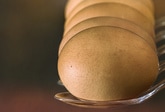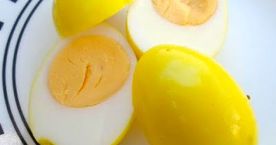 When I was first offered pickled eggs, it was at my uncle's home ... he's my husband's uncle or I would have probably been offered them as a child. I thought they were bar food, which to me means not real food. I also thought they sounded gross. However, I have been proven wrong and am willing to try most things. I've tried tripe, brains, and cartilage and am not really interested in eating them again. I've tried raw fish, sweatbread (thymus and other glands), and super-stinky cheese and liked them. Pickled eggs fall into the second category - tried them and liked them. If you are on a low-sodium diet, these are probably not for you. I don't know if there are low-sodium options. These eggs are good to slice up on a salad or have as a little protein and a lot of flavor with breakfast or for a snack. We like trying out different flavors - spicy ones are for the adults, pickly ones for the children. They are a great way to stretch peak season eggs into the low-production times. The first obstacle in pickling surplus farm-fresh eggs is getting boiled eggs that come out of the shell cleanly. Unlike supermarket eggs, the membrane between the egg and the shell is thick and strong. The shells are also harder and the whole egg really wants to stay together. It's well-built by healthy chickens. I've tried over a dozen ways to get them out of the shell without tearing up the white - vinegar in water, poking a small hole in one end, hot and cold, etc. - and I've found only one way that works consistently. First, it is important to start with OLD eggs. I aim for one month, but a little less will probably be fine. I've tried fresh before, and it was okay, but not as good. Set the eggs out at room temperature for an hour or two upside down from how they were stored in the fridge. I've also done overnight, but we keep our house cold. Allowing them to warm up a little helps reduce or prevent cracking from rapid temperature change when steaming. Turning them upside down causes the yolk, which has been sinking to the bottom of the egg, to float back up a little so the yolk is better centered in the egg. Get a large steamer and fill with the eggs. Start with water that is already simmering. Cover the eggs and steam (not boil in water) for 20 minutes. I've tried less time because we like our yolks a little softer, and anything below 18 minutes seems a little too soft. I also steam a large pot full at a time ... usually two dozen. Smaller batches may be okay with less time. While they steam, I prepare a large ice water bath. I use a really large bowl and a lot of ice, but not so much as to prevent the eggs from all slipping underwater when added. Also, I try to make sure there is enough room for all of the eggs without overflowing. When the eggs are done, I immediately put them into the ice water. I've left them in the basket and taken the out and find taking them out chills them faster - improved water flow around them. When they go from steaming to cold, the egg inside contracts and will sometimes crack the shell, which is fine. I leave them in the cold water for a minute or two so the inside isn't overly warm as it helps the white firm up. Then, I peel them under trickling cool water or with frequent rinsing dips in the ice bath water. I usually get nice-looking eggs. I plop the peeled eggs straight into half-gallon wide-mouth canning jars where they will be pickled. I fill them full of eggs, not pressing them in, but shaking it a little so they slide together tightly. Then, I pour over a warm - but not boiling - pickling liquid, cover, cool, and refrigerate for at least three days before starting to eat them. When I've poured over boiling liquid as most recipes instruct, it cooks the eggs more, especially the outer layer of the egg white, making it rubbery. By allowing it to cool first, it prevents this. I found no impairment of flavor absorption by the eggs from letting it cool. Flavor intensifies with time. They usually last 6-8 weeks in the fridge. Here are a few pickling liquids we use. The water added at the end does not dilute the pickling liquid, but is calculated in. I found I had a little extra (wasted) liquid most of the time when I just added a measured amount of water, so I add it at the end. There are also purple-red eggs made with pickled beets, but we haven't tried them yet. These recipes are certainly something to experiment with to find the flavor you like best. Each liquid batch is good for about 24 eggs in a half-gallon jar. Basic Eggs 1/4 c Pickling spice mix 2 c White or apple cider vinegar 1 sm Onion, sliced thin 15-20 Black peppercorns, whole 1/4 c Salt Water, as needed Simmer spices, vinegar, onion, peppercorn, and salt in the microwave or smalls saucepan until onions are soft and translucent. Cool so it is bath-warm. Pour over eggs. Add enough cool water to completely cover eggs. Secure on the lid. Turn upside down and back up several times to mix in the water and more evenly distribute the spices. ** For spicy eggs, add canned pickled jalapeno rings or slices to your taste - a whole undrained little can makes them nice and warm.  Mustard Eggs (Yellow) 1 1/2 t Mustard powder 1 1/2 t Turmeric, ground 1 T Honey (or mustard) 1 T Salt 3 c Apple cider vinegar Water, as needed Heat the above ingredients on stove top or in microwave. Whisk to combine. Pour over eggs in a jar. Add water, as needed, to cover the eggs. Cover with a lid. Gently turn upside down and back up to mix in the water and evenly distribute around eggs. If you want a little more of the honey-mustard flavor, try doubling or tripling the honey. It's also good with added whole white or black peppercorns and thinly sliced onions (cooked in heated liquid until well wilted). Chipotle Eggs
2 c Apple cider vinegar 4 t Garlic, minced or finely diced 1 sm Onion, thinly sliced 2 T Salt 1/4 c Sugar or honey 1 sm can Chipotle pepper in adobo sauce Water, as needed Combine vinegar, garlic, onion, salt, and sugar in a saucepan. Add the sauce from the can of peppers, and the desired number of peppers. I like mine medium warm, so two peppers (quartered) is usually good. My husband prefers about twice that. Heat until onions are soft and translucent. Cool to bath-warm. Pour over the eggs and add enough water to cover them. Put the lid on, turn upside down and back several times to mix in the water. Try adding a little dried oregano.
0 Comments
Your comment will be posted after it is approved.
Leave a Reply. |
Mindy HelmsWife to Brandon, mother to Tess and Liam, farmer, entrepreneur, cook & baker, nurse, and accountant who loves to try new things, travel, and work toward greater self-reliance. Archives
May 2024
Categories
All
|

 RSS Feed
RSS Feed
